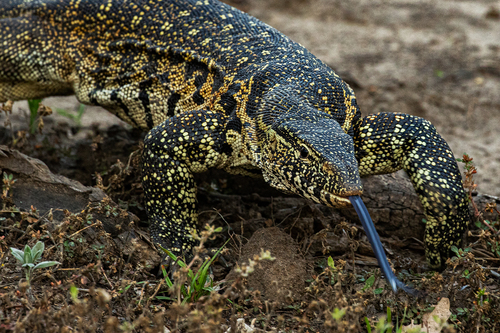
Nile Monitor
The Nile monitor, Varanus niloticus, is a formidable African predator, adept at swimming and climbing. With its striking scaled pattern and versatile diet, it plays a vital role in controlling prey populations. This adaptable reptile captivates with its powerful build and relentless curiosity in diverse environments.
20 years
Lifespan
5.9 - 19.96 kg
Weight
Length: 1.07 - 2.29 m
Size
18-24 months
Age of Sexual Maturity
High
Aggression
18 mph
Top Speed
Least Concern
Conservation Status
Stable
Population Trend
Characteristics
Varanus niloticus, also known as the Nile monitor, is a large lizard native to sub-Saharan Africa. It thrives in various habitats, including savannas, forests, and floodplains, often near water. Known for its sharp claws, powerful tail, and keen hunting skills, it preys on fish, birds, and small mammals.
Distribution Range of the Nile Monitor
Varanus niloticus, commonly known as the Nile monitor, is native to sub-Saharan Africa. Its distribution spans across a wide range of countries, including but not limited to Egypt, Sudan, Ethiopia, Kenya, Tanzania, Uganda, Democratic Republic of the Congo, and down to the southern parts of Africa such as Botswana and South Africa. The species is typically found in regions that are close to water bodies such as rivers, lakes, and swamps.
Nile Monitor's Habitat
Environmental Conditions
The Nile monitor inhabits a variety of environments, predominantly favoring areas with access to water. It thrives in habitats such as savannahs, grasslands, and forests that are near aquatic environments. The climate in these regions ranges from tropical to subtropical, with seasonal variations that may include wet and dry periods. The availability of water is a critical factor for their habitat preference, as it plays a significant role in their diet and breeding habits.
Ecological Niche
Varanus niloticus occupies an ecological niche as a semi-aquatic predator and scavenger. Its diet is diverse, consisting of fish, amphibians, small mammals, birds, eggs, and invertebrates, as well as carrion. This adaptability in diet helps it thrive in various environments. The Nile monitor is known for its excellent swimming abilities, which aid in hunting and escaping predators. It plays an important role in controlling the populations of its prey and in the ecosystem as a whole.
Copyright @ Nature Style Limited. All Rights Reserved.
 English
English